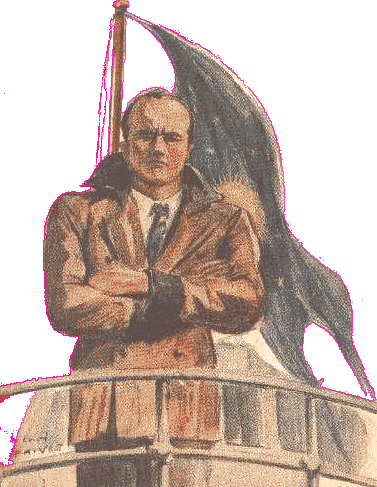
WHO WAS NOBODY?
The Life and Times of the Man We Knew as "Nemo"

WHO WAS NOBODY?
The Life and Times of the Man We Knew as "Nemo"
We're going to be looking for a man -- a man with a pronounced Napoleonic complex; a man often held to be a villain
by Society's standards, yet not evil. A man with prodigious charisma, and usually noble intentions (and we know
what paves the Road to Hell...), as well as a dark sense of humor.
A man who displays prodigious scientific knowledge, especially in the fields of engineering and mathematics. A
man who appears to hold the secrets to technology often ahead of his time. A man who shows remarkable organizational
skills in creating "secret empires", organizations of loyal men bound to him, sharing his misanthropic
ideals.
That man's character flaws are what ultimately bring him in conflict with others, who -- often blindly -- serve
Society. That man displays unbearable pride, an all too often frequent lapse in judgment, inflexibility and a steadfast
refusal to compromise.
And, let's face it, he chooses his adversaries very poorly...
1. The Narrative of Arthur Gordon Pym
 A story must begin somewhere, and this chronicle starts in 1836, when a gentleman named
Arthur Gordon Pym, claiming to have just returned to the United States, met writer-journalist Edgar Allan Poe,
and entrusted him with a Narrative,
subsequently published in the January and February 1837 of The Messenger under Poe's name.
A story must begin somewhere, and this chronicle starts in 1836, when a gentleman named
Arthur Gordon Pym, claiming to have just returned to the United States, met writer-journalist Edgar Allan Poe,
and entrusted him with a Narrative,
subsequently published in the January and February 1837 of The Messenger under Poe's name.
The book details the harrowing journey of the American brig Grampus in the South Seas, starting in the month of June, 1827. The narrative includes details of
a mutiny, an atrocious massacre, the recapture of the ship by the survivors, their eventual shipwreck, subsequemnt
famine and ultimate deliverance by the British schooner Jane Guy.
The Grampus's journey somewhat paralleled
Captain Cook's famous 1772 trip (aboard The Resolution),
or that of the Russian explorers Krusenstern and Lisianski. It actually anticipated the route of Benjamin Morrell,
whose 1832 narrative was entitled A narrative of four voyages to the South Sea, North and South Pacific Ocean,
Chinese Sea, Ethiopic and Southern Atlantic Ocean, Indian and Antarctic Ocean, from the year 1822 to 1831. There
was therefore nothing unusual in Pym's writing of the Narrative, or Poe's publishing the same.
Pym's Narrative then proceeds to tell
us of their cruise in the Antarctic Ocean, their encounter with strange creatures and phenomenons, and of the massacre
of the crew by a tribe of jet-black natives. Pym and another sailor, named Dirk Peters, escaped that grisly fate,
and journeyed further south, encountering increasingly mysterious phenomenons, such as lights in the sky, white
birds screaming their enigmatic "tekeli-li", ancient ruins with strange carvings, etc.
There, as it reaches an enigmatic crescendo, the Narrative stops. Poe states that Pym died, or vanished, soon afterwards, without completing his manuscript.
He also claims that Peters was living in Illinois, but could not be found.
The unanswered questions raised by The Narrarative of Arthur Gordon Pym are therefore:
1) What did Pym and Peters find in the Antarctic?
2) Where were they, and what did they do, between 1827 and 1836?
2. WHO WAS ARTHUR GORDON PYM?
Before embarking on a search for answers to these questions, let us first speculate on the background and ancestry
of Arthur Gordon Pym.
At the opening of his Narrative, Pym states:
"My father was a respectable trader in sea-stores at Nantucket, where
I was born. My maternal grandfather was an attorney in good practice."
We know that Nantucket was principally settled, first by the Quakers in 1659, then hit its peak just before the
Revolutionary War. Whaling was a big industry then, and attracted many immigrants, including French royalists fleeing
from the Revolution. We also know that Pym had a relative in New Bedford named Ross -- likely from the mother's
side of the family -- and that he was around 17 when he embarked on his fateful journey -- which would place his
birth in or around 1810.
The ethymology of the name "Pym" comes from the old french words "pyment" (piment) ou "pomandre"
(pomander) (cf. Webster's). The word "pomandre"
comes from the French words "pomme d'ambre",
a scented ball made of ambergris, spices, wine and honey, carried in a perforated container carried on the belt
or on a string around the neck. This aromatic device was an Italian invention. Even more interesting, it is also
a term found in 16th and 17th century alchemical treatises, such as Giovanni Maria Farina's 1732 works.
So there is reasonable evidence to assume that Pym's ancestor on his father's side was of French or Italian origins,
possibly by way of England, and when forced to adopt a new name, settled on one that contained a key to his former
life.
One likely candidate who springs to mind is none other than Joseph Balsamo, better known as... Cagliostro.
3. JOSEPH BALSAMO
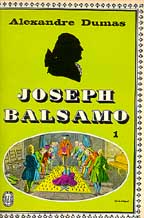 We are fortunate that the life of this fascinating character has been chronicled by various
authors: Goethe portrays him as the title character in Der Gross Cophta (1792) and even reportedly visited Joseph Balsamo's birthplace and met his family. Previously,
the Countess Von der Recke had featured Balsamo in Nachrichten von der Berüchtigen
Cagliostro Aufenthalt im Milan (Report
about the Stay of the famous Cagliosto in Milan; 1787). Friedrich Schiller
wrote about him in Der Geisterseher (The Visionary; 1787). And he is naturally referred to
in the memoirs of his contemporary and sometimes rival, Casanova. But the most interesting accont of his occult
carreer is, without a doubt, Alexandre Dumas' Joseph Balsamo (1846-48) and Le Collier de la Reine
(The Queen's Necklace; 1849-50). Thanks
to the research of Dumas, and his uncredited collaborator, Maquet, we have gained invaluable knowledge of Balsamo's
activities during the years 1770-74 and 1784-85.
We are fortunate that the life of this fascinating character has been chronicled by various
authors: Goethe portrays him as the title character in Der Gross Cophta (1792) and even reportedly visited Joseph Balsamo's birthplace and met his family. Previously,
the Countess Von der Recke had featured Balsamo in Nachrichten von der Berüchtigen
Cagliostro Aufenthalt im Milan (Report
about the Stay of the famous Cagliosto in Milan; 1787). Friedrich Schiller
wrote about him in Der Geisterseher (The Visionary; 1787). And he is naturally referred to
in the memoirs of his contemporary and sometimes rival, Casanova. But the most interesting accont of his occult
carreer is, without a doubt, Alexandre Dumas' Joseph Balsamo (1846-48) and Le Collier de la Reine
(The Queen's Necklace; 1849-50). Thanks
to the research of Dumas, and his uncredited collaborator, Maquet, we have gained invaluable knowledge of Balsamo's
activities during the years 1770-74 and 1784-85.
This is what we know. Joseph Balsamo was born in Palermo, Sicily, on 8 June 1743. His father was a book-seller.
Some claim his family had Jewish or Arabic ancestry -- an interesting connection in light of his future alchemical
career. Young Joseph was first schooled at the religious academy of Saint-Roch, then went to study at the Convent
of Caltagirone.
This is very important, because that convent was administered by the notorious criminal brotherhood of the Brothers
of Mercy, a proto-Mafia established in 1640 by Andrea Vitelli, a.k.a. Bel Demonio (Beautiful
Demon), the rightful heir to the title of Count of Monteleone, but dispossessed
by his cousin Ercole. Andrea Vitelli's extraordinary life has been chronicled in detail by Paul Féval.
(The story of Andrea Vitelli, the founder of one of the World's greatest criminal conspiracy of all times, is told
in our companion article, Will There Be Light Tomorrow?) .
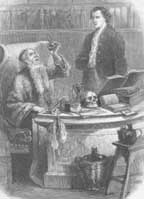 It is the Brothers of Mercy who not only enlisted Balsamo -- thereby making him part of
a powerful secret empire dedicated to the fall of the Monarchs -- but also acquainted him with alchemy and pharmacology.
Some sources claim that it is at Caltagirone that Balsamo met Altothas, an ancient alchemist about little is known. Thanks to Dumas, we know that Altothas claimed
to be 100-years old in 1774, and called Balsamo by the name of "Acharat."
It is the Brothers of Mercy who not only enlisted Balsamo -- thereby making him part of
a powerful secret empire dedicated to the fall of the Monarchs -- but also acquainted him with alchemy and pharmacology.
Some sources claim that it is at Caltagirone that Balsamo met Altothas, an ancient alchemist about little is known. Thanks to Dumas, we know that Altothas claimed
to be 100-years old in 1774, and called Balsamo by the name of "Acharat."
A note about alchemy: The popular misconception was that alchemists sought the secret of the philosopher's stone,
which was said to have the power to transmute base metal -- usually lead -- into gold. The reality was somewhat
more complex. The alchemist was dedicated to the Grand Oeuvre (great work), a life-long, time-consuming, spiritual and chemical process whose end-result was the production
of an elixir of long life. The so-called philosopher's stone was, by all accounts, a reddish powder dubbed "projection
powder." A small portion of it, wrapped in paper, was thrown into molten lead and, according to various witnesses,
did turn it into gold. The elixir of long life was, by all accounts, a red liquid, a mere drops of which could
revive the sick -- or act as the deadliest of poisons.
Whether alchemy is fact or fantasy may never be fully known; however, it is interesting to remark that, in the
Dark Ages, when the average life span was 38 years, noted alchemists such as Albertus Magnus (1193-1280), who wrote
five books about alchemy, including the treatise De Alchemia; Raymond Lulle (1235- 1315), who wrote Ars Magna; and the legendary gold-maker Nicolas Flamel (1330-1418), who wrote Explication
des Figures Hiéroglyphiques, all lived to reach their eighties.
Balsamo is shown to be in possession of the Elixir in Joseph Balsamo, but in Le Collier de la Reine
(Chapter II), he states that he does not have the formula for the Elixir itself, only three or four vials, likely
made for him by Altothas.
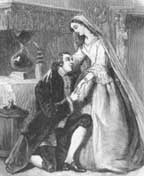 Before the events chronicled by Dumas in Joseph Balsamo, we know that Balsamo travelled with Altothas throughout Italy, Greece, Malta and the Middle
East, probably accomplishing various missions on behalf of the Brotherhood. In Malta, the two men were taken under
the protection of Dom Manoel Piato d'Alfonsera, Grand Master of the Knights of Malta. Then, they returned to Italy
and their trail is found in Naples and Rome. That's where Balsamo met his first wife, the beautiful Lorenza Feliciani, whom he married in April,
1769. They met with Casanova, then travelled to Germany and England, again serving as envoys between various Occult
/ Criminal societies. There are recorded meetings between Balsamo and Adam Weishaupt, founder of the Illuminati,
in Ingolstadt.
Before the events chronicled by Dumas in Joseph Balsamo, we know that Balsamo travelled with Altothas throughout Italy, Greece, Malta and the Middle
East, probably accomplishing various missions on behalf of the Brotherhood. In Malta, the two men were taken under
the protection of Dom Manoel Piato d'Alfonsera, Grand Master of the Knights of Malta. Then, they returned to Italy
and their trail is found in Naples and Rome. That's where Balsamo met his first wife, the beautiful Lorenza Feliciani, whom he married in April,
1769. They met with Casanova, then travelled to Germany and England, again serving as envoys between various Occult
/ Criminal societies. There are recorded meetings between Balsamo and Adam Weishaupt, founder of the Illuminati,
in Ingolstadt.
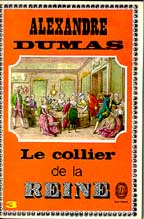 Then, Balsamo embarked on his mission to undermine the French Monarchy, chronicled
by Alexandre Dumas in Joseph Balsamo.
During the course of the novel, Althotas killed Lorenza, and was himself killed by Balsamo. At the end, Balsamo
left France -- we are now in 1774 -- and dispatched one of his proteges, young Gilbert, to Boston. Balsamo then
went to England and little is known about his activities there. When he returned, ten years later, he called himself
"Count of Cagliostro" . Back in Paris, he became the main architect of the scandalous affair of Queen
Marie-Antoinette's necklace, narrated by Dumas in Le Collier
de la Reine, which was one of the contributing factors to the French Revolution.
Then, Balsamo embarked on his mission to undermine the French Monarchy, chronicled
by Alexandre Dumas in Joseph Balsamo.
During the course of the novel, Althotas killed Lorenza, and was himself killed by Balsamo. At the end, Balsamo
left France -- we are now in 1774 -- and dispatched one of his proteges, young Gilbert, to Boston. Balsamo then
went to England and little is known about his activities there. When he returned, ten years later, he called himself
"Count of Cagliostro" . Back in Paris, he became the main architect of the scandalous affair of Queen
Marie-Antoinette's necklace, narrated by Dumas in Le Collier
de la Reine, which was one of the contributing factors to the French Revolution.
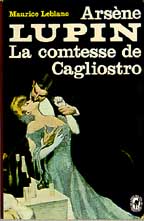 At the end of Le Collier de la Reine, Balsamo/Cagliostro was imprisoned in the Bastille, but with the help of his secret protectors,
he was merely banished and returned to England by way of Spain. From there, he returned to Italy. We know that
on 29 July 1788, a daughter, Josephine, was born in Palermo, her mother being identified only as Josephine de la
P., subject of the French crown Thanks to writer Maurice Leblanc's relationship with the notorious Arsène Lupin,
and his account of the facts in La Comtesse de Cagliostro, we know that that woman was none other than Josephine Tascher de la Pagerie, the maiden name
of Josephine de Beauharnais, the future wife of Napoleon.
At the end of Le Collier de la Reine, Balsamo/Cagliostro was imprisoned in the Bastille, but with the help of his secret protectors,
he was merely banished and returned to England by way of Spain. From there, he returned to Italy. We know that
on 29 July 1788, a daughter, Josephine, was born in Palermo, her mother being identified only as Josephine de la
P., subject of the French crown Thanks to writer Maurice Leblanc's relationship with the notorious Arsène Lupin,
and his account of the facts in La Comtesse de Cagliostro, we know that that woman was none other than Josephine Tascher de la Pagerie, the maiden name
of Josephine de Beauharnais, the future wife of Napoleon.
History records that Balsamo was imprisoned in 1789 in Italy and died in his cell at the Castle of Saint-Leon in
Urbin in 1795. However, is it likely that such a man, a high-ranking member of the Brotherhood of Mercy, possibly
the right-hand man to their Godfather, a Grand Master in several occult societies, would have meekly surrendered
to such a fate?
The pattern of fake deaths established by Bel Demonio is well known -- from Count of Monteleone to Fra Diavolo
to Colonel Bozzo and more. There is no reason to think that Balsamo did not benefit from the same methods. In fact,
speaking as Balsamo (Joseph Balsamo, Chapter
CLV), and again as Cagliostro (Le Collier de la Reine,
Chapter II), he declared his eventual intention of emigrating to the United States.
Coincidentally, the symbolic year of the "death" of Joseph Balsamo is also the year of the fall of the
Wold Newton meteorite. And thanks to Paul Féval's diligent research, we also know that Bel Demonio was in
England at the time, as Count Mario de Monteleone, posing as a "descendent" of Andrea, consolidating
his new criminal empire, dubbed the Companions of Silence.
It is therefore our contention that both Bel Demonio and Joseph Balsamo were present at Wold Newton in 1795, and
that Balsamo emigrated soon afterwards to the United States, where he took the name of Pym. Dumas noted that the
Elixir of Life spread a light balsamic scent, not unlike apples -- pommes in French... Was "Balsamo" even a real name? After all, Altothas called him "Acharat"
-- a mythical Arabian demon...
(More about Mario de Monteleone and the Wold Newton event of 1795 can be found in our companion article, Will There Be Light Tomorrow?)
.
Balsamo would have been 67 when he fathered Arthur, and in his eighties when his son embarked for his fateful journey,
not at all inconceivable for a Grand Master of the Brotherhood of Mercy, having some Elixir of Life at his disposal...
Or is the truth even stranger?
4. A DARING HYPOTHESIS
What if there was no Arthur Gordon Pym?
Or rather, what if Arthur Gordon Pym was
Joseph Balsamo?
After all, the only real evidence of young Arthur's existence is the first-person Narrative conveyed to Poe -- then a young man -- by a man who looked lke a prosperous, thirtyish man,
then disappeared, leaving a conveniently unfinished manuscript. Why do so, one may well ask. The answer is that
it is a well-established alchemical tradition for all alchemists, from Albertus Magnus to the early 20th century
Fulcanelli, to write roman à clefs
containg clues leading to great secrets for those willing to take up the quest. Certainly, Poe's Narrative can be read as an alchemical journey, with precious
but incomplete clues at the end.
Men like Bel Demonio, Adam Weisshaupt and Joseph Balsamo knew that the future belonged to science and technology.
They also had access to hidden knowledge, from long-vanished civilizations and races who lived on Earth before
Man. If Balsamo was to travel to the Antarctic to find these secrets, long-rumored to exist, the time was right.
Now let us return to our first question: What did Balsamo, now posing as Arthur Gordon Pym, find in the Antarctic?
5. THE SECRET OF THE ANTARCTIC
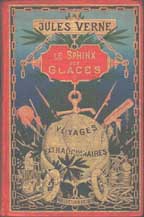 No one truly knows for certain what kind of fabulous secrets Joseph Balsamo,
now posing as Arthur Gordon Pym, found in the Antarctic. In 1897, Jules Verne wrote the novel Le Sphinx des Glaces in which another expedition, twelve
years later, travelled to the Antarctic and found Pym dead, impaled on a giant magnet shaped in the form of a Sphinx.
Yet, by reading Poe's account, Verne knew that Pym had returned to the United States in 1836. Verne was many things
but not a fool -- so why write a complete fabrication? As we will see below, Verne knew well what he was doing,
and this was not the first time that he became complicit in helping the man he knew under anoher name...
No one truly knows for certain what kind of fabulous secrets Joseph Balsamo,
now posing as Arthur Gordon Pym, found in the Antarctic. In 1897, Jules Verne wrote the novel Le Sphinx des Glaces in which another expedition, twelve
years later, travelled to the Antarctic and found Pym dead, impaled on a giant magnet shaped in the form of a Sphinx.
Yet, by reading Poe's account, Verne knew that Pym had returned to the United States in 1836. Verne was many things
but not a fool -- so why write a complete fabrication? As we will see below, Verne knew well what he was doing,
and this was not the first time that he became complicit in helping the man he knew under anoher name...
Another account, At the Mountains of Madness,
was written by H. P. Lovecraft in 1936. Likely to be more accurate, it nevertheless did not disclose the nature
of the fabulous discoveries of Pym and Peters. In fact we don't even know if there ever was a "Peters".
Poe could not locate him, and we only have Pym's word for his existence.
Noted theosophist Helene Petrovna Blavatsky (1831-1891) in her book The Secret
Doctrine (1888) dropped tantalizing hints about a mysterious race called the
Dzyan, who had unlocked the secrets of controlled matter-to-energy conversion, and more. Lord Bullwer-Lytton also
referred to a hiden race having mastered a form of energy dubbed the "Vril" in The
Coming Race (1871). All this may be part of the secrets that Pym gained when
he finally reached his long-sought goal.
Now let us address our second question: Where was Pym, and what did he do, between 1827 and 1836?
6. SEARCHING FOR PYM (1)
As the saying goes, if it looks like a duck, quacks like a duck... Having abandoned several identities before,
Pym would have indeed reappeared under a new guise. It is therefore by his actions, not his name, that we shall
know him.
Searching the historical records, we are struck that the year 1838 -- when according to Poe, Pym "died"
-- was the year when a mysterious traveller made his presence known throughout Europe and the Middle-East.
That traveller was a wealthy, enigmatic man identifying himself (as incredible as it may seem) as "Sinbad
the Sailor". Once again -- likely not a coincidence! -- we turn to Alexandre Dumas and his infatigable researcher
Maquet, who chronicled the life of this man in their 1845-46 novel, Le Comte
de Monte-Cristo.
First, what do we know about the so-called Count of Monte-Cristo?
-- That he was no Count.
-- That he was a master of disguise.
-- That he used at least three totally different identities: Sinbad the Sailor, Abbot Busoni, and Lord Wilmore.
-- That he had extensive connections with the Italian crime families (as evidenced by his friendship with godfather
Luigi Vampa) and Corsican crime families (as evidenced by the presence of ex-convict Bertuccio as his intendent).
-- That he exhibited arcane scientific knowledge.
-- That he had numerous contacts and connections with the Middle-East and the Orient.
-- That he owned a vial filled with a mysterious balsamic-smelling red liquid that could give life or death (and
which, in fact, he used to entice Madame de Villefort to poison her family).
-- That he was a misanthropic man, whose actions caused financial panic, social unrest and undermined two governments.
In short, we have every reason to believe that the Count of Monte-Cristo was none other than Joseph Balsamo, a.k.a.
the Count of Cagliostro, a.k.a. Arthur Gordon Pym!
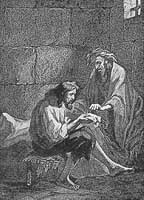 But wait! Wasn't Monte-Cristo really Edmond
Dantes, a Marseilles sailor unjustly imprisoned at the Chateau d'If in 1815,
following the slanderous accusations concocted by the jealous Fernand, the rapacious Danglars and the self-serving
Villefort?
But wait! Wasn't Monte-Cristo really Edmond
Dantes, a Marseilles sailor unjustly imprisoned at the Chateau d'If in 1815,
following the slanderous accusations concocted by the jealous Fernand, the rapacious Danglars and the self-serving
Villefort?
Let us examine the reasons why the Dantes-as-Monte-Cristo theory, while widely held due to Dumas' considerable
literary prowess, is in fact a convenient fabrication.
-- It is not likely that a barely educated sailor, weakened by fifteen years of imprisonment, could rise from such
ashes and become such a phoenix.
-- The tale of a buried treasure told to Dantes by the mad Abbot Faria also stretches believability. This is supposed
to be a treasure having belonged to the Borgias. So what happened to it during the intervening centuries between
the Borgias (which disappeared from history towards 1500) and the early 1800s when Faria is supposed to have gotten
wind of it? Why was such a treasure buried on a godforsaken spot such as Monte-Cristo island? Dubious provenance,
unbelievable story, told by a madman... Is it any wonder that one may question the veracity of such a tale?
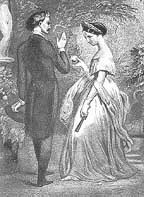 -- Monte-Cristo ultimately did not "rescue" Dantes' long-lost love Mercedes (in fact, his actions ruined her),
nor did he marry her (he already lived with another woman, Haydee). His main plot was directed against Villefort
and Fernand, by then two juicy political targets. On the other hand, the man most responsible for Dantes' predicament,
Danglars, was spared.
-- Monte-Cristo ultimately did not "rescue" Dantes' long-lost love Mercedes (in fact, his actions ruined her),
nor did he marry her (he already lived with another woman, Haydee). His main plot was directed against Villefort
and Fernand, by then two juicy political targets. On the other hand, the man most responsible for Dantes' predicament,
Danglars, was spared.
-- Even more interesting, Dumas later reported that he had based the Dantes revenge yarn on a tale of real-life
revenge. Dumas credits as his main inspiration an article entitled Le Diamant
et la Vengeance written by someone named Peuchet in 1837. According to Peuchet,
in 1807 in Paris lived a cobbler named Francois Picaud. He was planning to marry a local girl (who was fairly well
off) when an older jealous suitor named Mathieu Loupian (assisted by three barfly friends) wrote a letter to the
police accusing Picaud of being a British spy. Picaud was arrested and released only in 1814 (due to the fall of
Napoleon). In the meantime, the girl had married Loupian. In jail, Picaud had been befriended by a rich Milanese
who had died leaving him a diamond. Once free, as Peuchet tells the story, Picaud used various fake identities
to con one of the barflies (a man named Allut) in telling him the true story of what had happened. Then he infiltrated
Loupian's family circle and, unrecognized, destroyed them all. But a remorseful Allut who, in the meantime, had
put two and two together, captured Picaud and starved him to death trying to get whatever was left of the diamond's
money. Allut then fled France, travelled to England and eventually confessed the story on his death bed to a priest.
Peuchet claimed that the priest sent the confession to the prefecture of police of Paris where he found it. On
this rather sordid tale, Dumas and Maquet grafted additional material, drawn from the former's travel impressions
of his trips to Italy, as well as information received from the real Count of Monte-Cristo.
We are led to wonder if Dumas knew, or guessed, who the man he knew as Monte-Cristo truly was; if he recognized
him as Joseph Balsamo and Cagliostro... If he did, he certainly would have been motivated to obscure the real facts,
and wrap them in this lurid, pulpish tale of revenge. It certainly was not the first, nor the last time, that writers
were used as willing accomplice by the man we've come to know as Pym.
6. SEARCHING FOR PYM (2)
Now that we have established where Arthur Gordon Pym was in 1838, and what he was doing, it is easier to theorize
backwards as to his activities during the preceding decade.
It is not unreasonable to assume that it must have taken Pym a good ten years to understand, then exploit, the
secrets that he had found in the Antarctic. Even a modern scientist, if given a wrecked UFO, would spend many years
doing reverse engineering.
Also, Pym must have renewed his links with his former associates -- certainly Monte-Cristo appeared to share in
his revolutionary zeal -- and created new identities for himself all over the world. It is easy then to assume
that Pym was on board the Corsican smuggling vessel that picked up the dying Edmond Dantes after his fateful escape
from the Chateau d'If in 1829. Whether Dantes lived or died thereafter is ultimately unknown, but certainly he
knew his revenge was in good hands, entrusted to a man such as Pym.
Thanks to Dumas and Maquet's painstaking researtch, we know that Pym, now operating as Monte-Cristo, commissioned
the building of special ships, and planned to operate from a special island that would later become one of his
bases of operations.
Monte-Cristo's vast fortune deposited with banks such as Thomson & French, Rotschild, and others, and his web
of aliases and oriental connections, as well as his anti-imperialist opinions, leads us to postulate another hypothesis:
that one of Monte-Cristo's identities was none other than that of the Indian Prince Dakkar, a man involved in the
Sepoy Rebellion of 1858.
7. PYM AS "NOBODY"
 Readers familiar with Jules Verne's accounts of the life of the man known only
as Captain Nemo -- 20.000 Lieues sous les Mers and L'Ile Mysterieuse
-- will recognize that alias as the name revealed by Verne to be the secret identity of Nemo in the latter volume.
Readers familiar with Jules Verne's accounts of the life of the man known only
as Captain Nemo -- 20.000 Lieues sous les Mers and L'Ile Mysterieuse
-- will recognize that alias as the name revealed by Verne to be the secret identity of Nemo in the latter volume.
We need not repeat the similarities that exist between Monte-Cristo and Nemo, as they are basically the same as
those between Balsamo/Pym and Monte-Cristo.
Monte-Cristo vanished in 1846. The Nautilus
was first sighted in 1866. No one knows for certain what Pym did during these twenty years -- in addition to building
the Nautilus. Certainly, the nuclear-
or vril-powered engines of the Nautilus
could only be explained by the discoveries made by Pym in the Antarctic, and it could not have been built in total
secrecy overnight. In fact, the building of the Nautilus
(and later the Albatros and Captain Mors'
ship) is possible only when taking into account Pym's vast criminal underground connections.
Because of his connection with Bel Demonio, now operating as Colonel Bozzo, Godfather of the Black Coats, we certainly
can speculate on what role Pym may have played during these twenty years. In London, he must have interfaced with
John Devil and later, with Moriarty; in France, he had trucking with the Habits Noirs and Rocambole; in Germany, he almost certainly trained
Captain Mors; and in India, he taught Erik in Mazenderan and took part in the Sepoy Rebellion of 1858 as Dakkar.
He may have met Fu-Manchu in the Far East...
(More about this criminal conspiracy in our companion article, Will
There Be Light Tomorrow?).
Verne's friendship with the man he knew as Nemo helps us solve two mysteries:
-- Verne's deliberate fudging of the dates in L'Ile Mysterieuse -- which became responsible for the rather far-fetched theories of W. H. Starr, reprised by
Philip Jose Farmer in The Other Log of Phileas Fogg,
that Nemo and Moriarty were one and the same. While Nemo certainly met Moriarty -- after all, they were both Masters
of the Black Coats -- they were not the same. They were physically, intellectually and philosophically very different
beings. In a note, Verne remarks that his readers may observe "some discrepancy
in the dates; but later they will understand why the real dates were not given at first."
Yet, there is nothing in the book that leads to any such understanding...
We believe that the basic events of L'Ile Mysterieuse
did take place in or before 1874, but were heavily edited by Verne to make them sound as if they had taken place
a decade before -- such as dropping in a reference to the American Civil War. And that it was part of an elaborate
ploy by Nemo to make the world at large believe that he was dead -- obviously Professor Arronax' report of his
demise in the Maelstrom had not been deemed sufficient -- and further, that he was aided and abetted by his confidente,
Verne, in such a bit of disinformtion. This is further bolstered by the fact that in L'Ile
Mysterieuse, Verne reports that his heroes found a man (Ayerton) that had
been abandoned "twelve years earlier"
(!) in Les Enfants du Capitaine Grant
-- a record dated around 1864!
-- This also explains why the same tactic was employed again, deliberately, by Verne in Le
Sphinx des Glaces, now stating that Pym had died in the Antractic, when Poe's
own account was that he had met with the man in 1936! Why would Verne even bother telling such a story -- a far
cry from his other novels -- if not to help Nemo cover his tracks?
8. FIRST MAN TO THE STARS
 Whether Nemo took part in Phileas Fogg's celebrated 1872 journey around the world as Philip
Jose Farmer believes remains to be determined. Some also see Nemo's hand in the underground industrial civilization
of the "Indes Noires", and the
rise of Captain Mors in Germany...
Whether Nemo took part in Phileas Fogg's celebrated 1872 journey around the world as Philip
Jose Farmer believes remains to be determined. Some also see Nemo's hand in the underground industrial civilization
of the "Indes Noires", and the
rise of Captain Mors in Germany...
There is indeed a body of evidence leading us to believe that, starting in the 1870s, Nemo became involved in space
travel. He was undoubtedly the man who designed the spaceship the Astronaut and flew to Mars in 1880, as recorded by Percy Greg in Across
the Zodiac, thus becoming the first Earthman to fly to Mars under his own
power.
Nemo returned in 1882, this time using the alias of Dr. Antekirtt, master hypnotist and lord of the secret island
Antekirtta. This account, written by Jules Verne again, under the title Mathias
Sandorf, attempted to connect Antekirtt to a wronged Transylvanian nobleman
named Mathias Sandorf arrested in 1867. But like Dumas with his Edmond Dantes story, this was but a transparent
ploy, in fact one almost literally copied from Dumas.
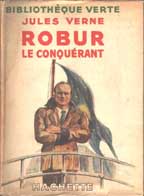 In 1886, it was under the alias of Robur, that Pym returned, using his advanced science
to demonstrate the superiority of his flying machine, the Albatross. Repaying his obligations to Verne, Pym let him chronicle this story under the title of Robur le Conquerant. Robur is merely another
alias, just another cryptogram, like "Pym" or "Nemo."
In 1886, it was under the alias of Robur, that Pym returned, using his advanced science
to demonstrate the superiority of his flying machine, the Albatross. Repaying his obligations to Verne, Pym let him chronicle this story under the title of Robur le Conquerant. Robur is merely another
alias, just another cryptogram, like "Pym" or "Nemo."
In 1890, Nemo returned to Mars in another spaceship, the Steel Globe -- as recorded by Robert Cromie's A Plunge into Space, which, tellingly, was prefaced by Jules Verne.
In 1894, Nemo teamed up with American multimillionaire John Jacob Astor to build the Callisto, and engaged into more mysterious outer space activities, chronicled by Astor in his book,
A Journey to the Other Worlds.
In 1896, Nemo was found again at the helm of another spaceship in yet another Across
the Zodiac account, this time penned by British author Edwin Pallander.
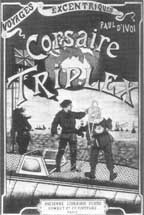 Paul d'Ivoi chronicled Nemo's further underwater adventures under the name of "Corsair Triplex" in
an eponymous colorful account released in 1898.
Paul d'Ivoi chronicled Nemo's further underwater adventures under the name of "Corsair Triplex" in
an eponymous colorful account released in 1898.
That same year, Pym and Astor collaborated with Thomas Alva Edison to launch a counter-attack on Mars, reported
under the misleading title Edison's Conquest of Mars
by Garrett Serviss.
There is no doubt that Pym continued to play an active behind-the-scenes role in Earth's space exploration in the
early 1900s. Thanks to his Indian connections, he helped young engineer Robert Darvel build a spaceship which travelled
to Mars, and helped defend Earth in the ensuing second invasion, chronicled by Gustave Le Rouge in his 1908 novel
Le Prisonnier de la Planète Mars.
With his friend and business partner John Jacob Astor, he was likely a member of the the Billionaires' Conspiracy
whose existence was revealed by Le Rouge in La Conspiration des Milliardaires.
Pym subsequently explored the Solar System with his German pupil Captain Mors in 1908-11, and may have been aboard
the spaceship Sannah when it made its
first journey to another star in 1911 as recorded by Friedrich Mader in Wunderwelten (Distant Worlds).
(For more about the Conquest of Space and Nemo's role in it, refer to our companion article, Manifest Destiny.)
9. THE MAN WHO WAS NOBODY
During World War I, Gaston Leroux found evidence of Pym/Nemo's return, again as another avenging sub-mariner, Captain
Hyx, and portrayed him in his romanticized account, Les Aventures Effroyables
de Herbert de Renich (1917).
Other aliases are more uncertain:
Pym may have been the man known as Marc "Blackie" DuQuesne who thwarted rocketeer Richard Seaton in 1915,
as recorded by Dr. E. E. Smith (later accounts being obviously fictional embellishments).
Was Pym the Leonid Zattan who fought the Nyctalope to a standstill in 1920?
In the late 1930s, Pym may well have been John Sunlight, the only man to have outsmarted Doc Savage. And, more
recently, the name of multimillionaire Stormberg, who was ultimately defeated by James Bond, is worth considering.
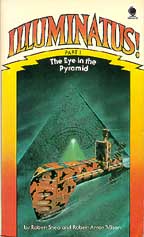 A thorough combing of the records left by great crime-fighters of the 1930s
to today will undoubtedly turn up more evidence of Pym's activities.
A thorough combing of the records left by great crime-fighters of the 1930s
to today will undoubtedly turn up more evidence of Pym's activities.
Certainly, the notorious Hagbard Celine, whose colorful career was chronicled by Robert Shea and Robert Anton Wilson
in their Illuminatus Trilogy,
is almost certainly one of the latest avatars of the man we knew at various times as Joseph Balsamo, Cagliostro,
Arthur Gordon-Pym, Monte-Cristo, Lord Wilmore, Abbot Busoni, Prince Dakkar, Captain Nemo, Dr. Antekirtt, Robur,
Triplex, Captain Hyx and more... A man who truly is NOBODY.